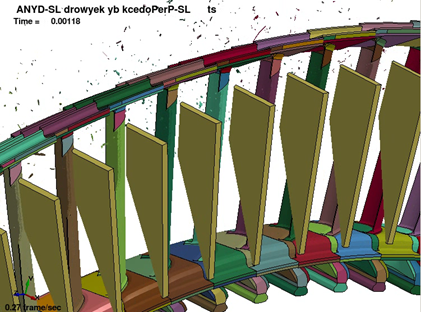Low pressure turbine structural analysis
JAXA Supercomputer System Annual Report April 2016-March 2017
Report Number: R16E0026
- Responsible Representative: Toshio Nishizawa(Aeronautical Technology Directorate, aFJR project team)
- Contact Information: Masahiro Hojo(hojo.masahiro@jaxa.jp)
- Members: Kenshirou Kondou, Shota Sadamoto, Masahiro Hojo, Masaharu Ando, Takuya Ando, Tomoaki Watanabe, Itaru Kusunoki
- Subject Category: Aviation(Aircraft engine)
Abstract
The purpose of aFJR project is to advance research on jet engine component technologies so that Japanese manufacturers can join more effectively in international joint-development projects on next-generation jet engines. Application of a Ceramic Matrix Composite (CMC) to low pressure turbine blade material is conducted to reduce the engine weight in the aFJR project.
Goal
Please refer ‘aFJR (Advanced Fan Jet Research) project | ECAT – Environment-Conscious Aircraft Technology Program | Aeronautical Technology Directorate‘.
Objective
Please refer ‘aFJR (Advanced Fan Jet Research) project | ECAT – Environment-Conscious Aircraft Technology Program | Aeronautical Technology Directorate‘.
References and Links
Please refer ‘aFJR (Advanced Fan Jet Research) project | ECAT – Environment-Conscious Aircraft Technology Program | Aeronautical Technology Directorate‘.
Use of the Supercomputer
The CMC low pressure turbine blade was designed based on the analysis results using JSS2. The next step is to demonstrate the CMC blade design methodology and to validate the analysis results using demonstration test results.
Necessity of the Supercomputer
It is necessary to use JSS2 to handle large analysis models in the present cases.
Achievements of the Year
Figure 1 shows the analysis result of the cascades of CMC low pressure turbine blades at the moment of contact with the cascade of stator vanes. It was found that the cascade of CMC rotor blades were fractured within the time specified.
Publications
N/A
Computational Information
- Parallelization Methods: Hybrid Parallelization
- Process Parallelization Methods: MPI
- Thread Parallelization Methods: OpenMP
- Number of Processes: 128
- Number of Threads per Process: 4
- Number of Nodes Used: 32
- Elapsed Time per Case (Hours): 50
- Number of Cases: 3
Resources Used
Total Amount of Virtual Cost(Yen): 11,976,837
Breakdown List by Resources
| System Name | Amount of Core Time(core x hours) | Virtual Cost(Yen) |
|---|---|---|
| SORA-MA | 7,229,420.22 | 11,678,095 |
| SORA-PP | 0.00 | 0 |
| SORA-LM | 1,854.02 | 41,715 |
| SORA-TPP | 0.00 | 0 |
| File System Name | Storage assigned(GiB) | Virtual Cost(Yen) |
|---|---|---|
| /home | 511.81 | 4,827 |
| /data | 16,555.79 | 156,171 |
| /ltmp | 9,114.59 | 85,978 |
| Archiving System Name | Storage used(TiB) | Virtual Cost(Yen) |
|---|---|---|
| J-SPACE | 3.25 | 10,049 |
Note: Virtual Cost=amount of cost, using the unit price list of JAXA Facility Utilization program(2016)
JAXA Supercomputer System Annual Report April 2016-March 2017



